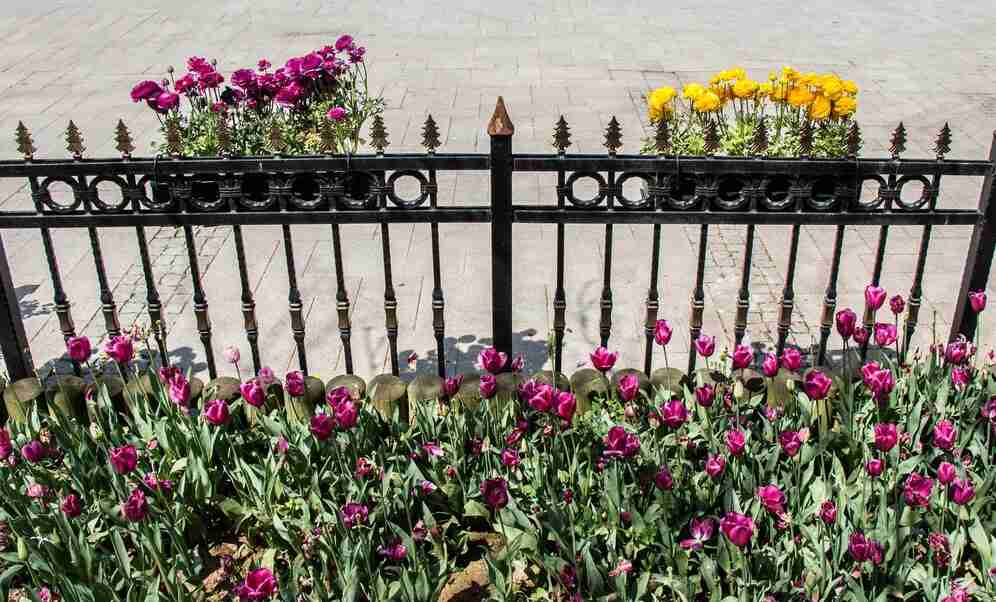
In the world of gardening, where creativity meets horticulture, the art of cultivating a stunning outdoor space goes beyond planting and pruning. One often underestimated yet crucial aspect of a well-manicured garden is its borders. Garden borders not only add definition to the landscape but also serve functional purposes, from delineating different areas to preventing soil erosion. Among the myriad options available for garden edging, fences have emerged as an innovative and stylish solution, elevating the concept of garden borders to new heights.
Picture this: a lush, vibrant garden framed by carefully chosen fences, creating a harmonious balance between nature and design. In this blog, we will delve into the world of “Garden Edging with Fences: The Perfect Border,” exploring the functionality, benefits, and creative possibilities that fences bring to the realm of garden design. From traditional materials like stones and bricks to the contemporary charm of fences, we will unravel the secrets of achieving the ideal garden border that not only enhances the aesthetic appeal but also adds structure and purpose to your outdoor haven.
Join us on this journey as we discover why fences are becoming the go-to choice for garden edging enthusiasts, offering durability, versatility, and a touch of sophistication to transform your garden into a picturesque haven.
The Functionality Of Garden Edging
Garden edging serves as a fundamental element in landscaping, offering both practical functionality and aesthetic appeal. At its core, garden edging defines and separates various elements within a landscape, creating distinct borders between different areas such as flower beds, pathways, and lawns. The primary functionality of garden edging lies in its ability to provide structure and organization to outdoor spaces.
One of the key benefits of garden edging is its role in preventing the encroachment of grass, weeds, and other unwanted plants into designated areas. By acting as a barrier, edging materials such as stones, bricks, or, in this case, fences, help maintain a well-groomed appearance while minimizing the effort required for ongoing maintenance. This containment function not only preserves the integrity of individual garden elements but also facilitates easier lawn care.
Beyond its practical utility, garden edging contributes significantly to the visual appeal of a landscape. It adds definition and sharpness to the overall design, creating clean lines that enhance the aesthetic harmony of the garden. Additionally, well-designed edging can complement the style and theme of the garden, providing a cohesive and polished look. The functionality of garden edging, therefore, extends beyond the utilitarian aspects, playing a crucial role in elevating the beauty and orderliness of outdoor spaces.
Types Of Garden Edging
There are various types of garden edging options available, each offering a unique aesthetic and functional appeal. Here are some popular types of garden edging:
- Traditional Materials:
- Bricks and Pavers: These classic options provide a timeless and elegant look. They are durable, easy to install, and can be arranged in various patterns.
- Stones: Natural stones or concrete stones are often used for a rustic and organic border. They come in different shapes and sizes, adding a natural touch to the garden.
- Metal Edging:
- Steel or Aluminum Edging: These materials provide a sleek and modern appearance. They are durable, corrosion-resistant, and suitable for creating clean lines in contemporary garden designs.
- Wooden Edging:
- Railway Sleepers or Timber: Wood adds warmth to the garden and can be used for both traditional and contemporary styles. It’s versatile and can be easily customized to fit different shapes.
- Plastic Edging:
- Flexible Plastic Strips: Ideal for creating curves and fluid lines in the garden. They are lightweight, easy to install, and cost-effective.
- Concrete Edging:
- Molded Concrete Borders: These pre-formed concrete options are durable and come in various designs. They offer a sturdy and permanent solution for garden borders.
- Fence Edging:
- Decorative Fences: Utilizing decorative fences as edging provides a unique and eye-catching border. Fences can be made from various materials such as wood, metal, or vinyl, offering both practicality and aesthetics.
- Living Edges:
- Hedging Plants: Using plants like boxwood or lavender to create natural borders. This living edging option adds a soft and organic touch to the garden.
- Gabion Walls:
- Wire Mesh Filled with Stones: Gabions provide a modern and industrial look. They are excellent for retaining walls and creating defined borders with a touch of texture.
Choosing the right type of garden edging depends on factors such as the garden’s style, the desired level of maintenance, and the overall landscape design. Each type has its own set of advantages, allowing for flexibility in creating a customized and visually appealing garden border.

Benefits Of Using Fences For Garden Edging
- Enhanced aesthetics: Fences serve as an attractive frame for your garden, elevating its overall appearance. Whether you opt for a quaint picket fence, a rustic wooden border, or a sleek metal edging, the addition of a fence can instantly add charm and character to your outdoor space. By providing a structured outline, fences help to organize the landscape, creating visual interest and focal points within the garden. Furthermore, they can complement the architectural style of your home and tie together different elements of your outdoor design, such as pathways, patios, and flower beds.
- Defined garden boundaries: One of the primary functions of garden edging with fences is to clearly define the boundaries of your garden. This not only demarcates your property lines but also establishes distinct areas within your landscape. By creating a clear separation between your garden and other parts of your yard, such as lawns, driveways, or walkways, fences help prevent accidental encroachment or damage to delicate plants. Additionally, they can act as a barrier to deter unwanted foot traffic, pets, or wildlife from entering your garden, thereby protecting your plants and preserving their integrity.
- Increased garden organization and maintenance: Fences provide a practical solution for organizing and maintaining your garden. By delineating specific areas for different types of plants or garden features, such as flower beds, vegetable patches, or herb gardens, fences help streamline your gardening tasks. This division makes it easier to access and tend to individual plants, reducing the risk of trampling or damage during maintenance activities. Moreover, fences can serve as a backdrop for vertical gardening techniques, such as trellising or espalier, allowing you to maximize space and cultivate a wider variety of plants within a confined area. As a result, your garden becomes more efficient to manage, with less time spent on maintenance and more time enjoying its beauty.
- Versatility in design and materials: One of the key advantages of using fences for garden edging is the wide range of design options and materials available. From traditional wooden fences to contemporary metal designs, there’s a fence style to suit every taste and garden aesthetic. Wood fences, such as cedar, redwood, or pressure-treated varieties, offer a natural look that blends seamlessly with the landscape and can be customized with stain or paint for added flair. Metal fences, including wrought iron, aluminum, or steel, provide durability and strength, ideal for creating elegant borders or decorative accents. Additionally, vinyl fences offer low-maintenance alternatives that resist rot, decay, and insect damage, perfect for busy gardeners seeking hassle-free solutions. With such versatility in design and materials, you can choose the fence that best complements your garden’s style, while also meeting your functional requirements and budget constraints.
Maintenance Tips For Long-lasting Garden Edging With Fences
A. Regular cleaning:
- Remove debris such as leaves, dirt, and grass clippings from the fence regularly. Use a brush or a soft cloth to wipe down the surface.
- For wooden fences, gently scrub with a mild detergent solution and water to remove stains or mold buildup. Rinse thoroughly afterward.
B. Inspecting for damage:
- Conduct routine inspections of the fence for any signs of damage such as cracks, splinters, or rust.
- Pay special attention to areas where the fence meets the ground or where there may be moisture buildup, as these are common areas for damage to occur.
C. Repairing and treating wood fences:
- Promptly repair any damage to wooden fences, such as loose boards or broken panels. Replace any rotted or damaged wood.
- Apply a wood preservative or sealant to protect the wood from moisture, rot, and insect damage. Reapply as needed according to the manufacturer’s instructions.
D. Rust prevention for metal fences:
- Regularly inspect metal fences for signs of rust, especially in areas where the paint or coating may have been scratched or worn away.
- Sand away any rust spots using sandpaper or a wire brush, then apply a rust-inhibiting primer and paint to protect the metal from further corrosion.
- Consider applying a clear sealant or wax coating to provide an additional layer of protection against rust and corrosion.
In conclusion, incorporating fences as garden edging offers a multitude of benefits, from enhancing the visual appeal of your outdoor space to providing structure and organization to your garden beds. By choosing the right type of fence and following proper installation techniques, you can achieve the perfect border that not only defines your garden but also complements its overall theme and style. Additionally, with regular maintenance and care, such as cleaning, inspecting for damage, and addressing any issues promptly, you can ensure that your garden edging with fences remains in optimal condition for years to come. So, whether you opt for the timeless charm of wooden picket fences or the sleek elegance of metal or vinyl options, let your creativity flourish and transform your garden into a stunning oasis with the perfect fence border.
 Se Habla Español
Se Habla Español


